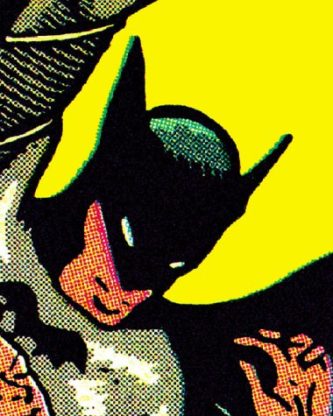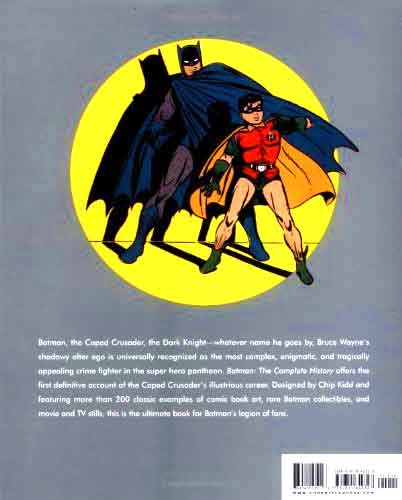 By LES DANIELS (Chronicle Books; 1999)
By LES DANIELS (Chronicle Books; 1999)
This 1999 publication is obviously a bit out of date, but is otherwise an admirably exhaustive recounting of the exploits of the Caped Crusader, a.k.a. Batman. The late Les Daniels (of the essential history-of-horror volume LIVING IN FEAR, as well as book-length histories of Superman and Wonder Woman) was the author, and traces Batman’s chronology with the zeal of a master detective.
… traces Batman’s chronology with the zeal of a master detective.
Batman was created by artist Bob Kane (questions have been raised about the true extent of Kane’s involvement in Batman’s inception, but Daniels takes him at his word). The dark inverse of Superman, who was proving to be exceedingly popular in DC Comic’s Action Comics, Batman was conceived as sort of a cross between Zorro and Dracula, and made his debut in the pages of DC’s Detective Comics in May 1939.
Success didn’t come until 1940, when Batman’s plucky sidekick Robin made his debut. It was that same year that Batman got his own self-titled comic, the premiere issue of which introduced the Joker and Catwoman. A plethora of colorful villains followed, including iconic figures like Two-Face, the Scarecrow and the Riddler. The 1940s also saw Batman’s screen debut in the form of the Columbia serials BATMAN and BATMAN AND ROBIN, the first of which, according to Daniels, “isn’t very good” (he’s right), while the sequel “wasn’t much of an improvement.”
The late Les Daniels (of the essential history-of-horror volume LIVING IN FEAR, as well as book-length histories of Superman and Wonder Woman) was the author, and traces Batman’s chronology with the zeal of a master detective.
 The first of several radical changes to the Batman mythos occurred in the mid-1950s. The catalyst was Fredric Wertham’s infamous tract THE SEDUCTION OF THE INNOCENT, which claimed comics inspired antisocial behavior in children, and singled out BATMAN for its perceived homosexual overtones. As a result Batman’s dark edges were blunted and the comic turned into a family-oriented trifle (complete with a Bat Hound, Bat Girl and Bat Mite).
The first of several radical changes to the Batman mythos occurred in the mid-1950s. The catalyst was Fredric Wertham’s infamous tract THE SEDUCTION OF THE INNOCENT, which claimed comics inspired antisocial behavior in children, and singled out BATMAN for its perceived homosexual overtones. As a result Batman’s dark edges were blunted and the comic turned into a family-oriented trifle (complete with a Bat Hound, Bat Girl and Bat Mite).
Things turned around again in 1964, with the addition of DC’s new editor Julius Schwartz, who abandoned Bob Kane’s signature artwork and lent the series a staunch detective story orientation (Kane, for the record, left the series in 1967, together with his longtime “collaborator”–a.k.a. ghost artist–Sheldon Moldoff). A far greater influence on the evolution of Batman arrived two years later in the form of a wildly campy TV series, which more than anything else was responsible for turning the character into an icon. The comics, however, charted a far darker course, led by artist Neal Adams, whose Batman was “presented with the mystery and menace of bygone days, but portrayed with artistic flourishes by Adams that seemed altogether new.”
The next big evolution was in 1986, when the iconic 4-issue comic THE DARK KNIGHT RETURNS, scripted and illustrated by Frank Miller, premiered. It provided the darkest, grittiest portrayal of Batman yet, and led to a string of BATMAN graphic novels (ARKHAM ASYLUM, THE KILLING JOKE, etc) and also the 1989 blockbuster movie version. That movie inspired three sequels, a well-received animated series and a flood of comic book interpretations, at least one of which re-imagined Batman as a vampire.
This “Complete History” appeared long before the caped crusader’s most recent appearances in the Christopher Nolan directed DARK KNIGHT film trilogy, but the history it outlines is a solid and thoroughly researched one. Also contained are a wealth of photos and artwork (including three BATMAN comics presented in their entirety) that by themselves constitute an excellent pictorial record of Batman’s evolution.
